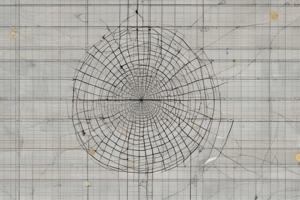Podcast
Questions and Answers
The equation of a circle with center at $(h, k)$ and radius $r$ is given by $(x - h)^2 + (y - k)^2 = ______$, which follows from the Pythagorean theorem applied to the circle's radius and the coordinates.
The equation of a circle with center at $(h, k)$ and radius $r$ is given by $(x - h)^2 + (y - k)^2 = ______$, which follows from the Pythagorean theorem applied to the circle's radius and the coordinates.
r^2
To find the area of a polygon plotted on the coordinate plane, one common strategy involves ______ the polygon into triangles and summing their areas, utilizing coordinate geometry techniques to calculate necessary lengths and heights.
To find the area of a polygon plotted on the coordinate plane, one common strategy involves ______ the polygon into triangles and summing their areas, utilizing coordinate geometry techniques to calculate necessary lengths and heights.
decomposing
Given two points $A(x_1, y_1)$ and $B(x_2, y_2)$ on the coordinate plane, the ______ of the line segment $AB$ is found using the formula $\sqrt{(x_2 - x_1)^2 + (y_2 - y_1)^2}$.
Given two points $A(x_1, y_1)$ and $B(x_2, y_2)$ on the coordinate plane, the ______ of the line segment $AB$ is found using the formula $\sqrt{(x_2 - x_1)^2 + (y_2 - y_1)^2}$.
length
The coordinates of the center of a circle given by the equation $(x + 3)^2 + (y - 4)^2 = 25$ are (______, 4), indicating a horizontal shift to the left and a vertical shift upwards from the origin.
The coordinates of the center of a circle given by the equation $(x + 3)^2 + (y - 4)^2 = 25$ are (______, 4), indicating a horizontal shift to the left and a vertical shift upwards from the origin.
To prove that a quadrilateral on the coordinate plane is a parallelogram, you must demonstrate that both pairs of opposite sides are ______ by showing they have equal slopes.
To prove that a quadrilateral on the coordinate plane is a parallelogram, you must demonstrate that both pairs of opposite sides are ______ by showing they have equal slopes.
If a circle in the coordinate plane has a diameter with endpoints at $(1, 2)$ and $(7, 10)$, the coordinates of the center of the circle are the ______ of these endpoints, calculated as $((1+7)/2, (2+10)/2)$.
If a circle in the coordinate plane has a diameter with endpoints at $(1, 2)$ and $(7, 10)$, the coordinates of the center of the circle are the ______ of these endpoints, calculated as $((1+7)/2, (2+10)/2)$.
The radius of the circle defined by the equation $(x - 5)^2 + (y + 1)^2 = 16$ is ______ because the equation is in the standard form $(x - h)^2 + (y - k)^2 = r^2$, thus $r = \sqrt{16}$.
The radius of the circle defined by the equation $(x - 5)^2 + (y + 1)^2 = 16$ is ______ because the equation is in the standard form $(x - h)^2 + (y - k)^2 = r^2$, thus $r = \sqrt{16}$.
To determine if a point $(x, y)$ lies inside, outside, or on the circle defined by $(x - h)^2 + (y - k)^2 = r^2$, you would compare the calculated value of $(x - h)^2 + (y - k)^2$ with ______; a value less than, equal to, or greater than it indicates inside, on, or outside the circle, respectively.
To determine if a point $(x, y)$ lies inside, outside, or on the circle defined by $(x - h)^2 + (y - k)^2 = r^2$, you would compare the calculated value of $(x - h)^2 + (y - k)^2$ with ______; a value less than, equal to, or greater than it indicates inside, on, or outside the circle, respectively.
The area of a rectangle with vertices at $(1, 2)$, $(5, 2)$, $(5, 7)$, and $(1, 7)$ can be found using the formula $Area = length \times width$, where the length is the distance between $(1, 2)$ and $(5, 2)$, and the width is the distance between $(5, 2)$ and (______, 7).
The area of a rectangle with vertices at $(1, 2)$, $(5, 2)$, $(5, 7)$, and $(1, 7)$ can be found using the formula $Area = length \times width$, where the length is the distance between $(1, 2)$ and $(5, 2)$, and the width is the distance between $(5, 2)$ and (______, 7).
In coordinate geometry, the slope of a line segment joining points $(x_1, y_1)$ and $(x_2, y_2)$ is given by the formula $m = (y_2 - y_1) / ______$, which measures the rate of change of $y$ with respect to $x$.
In coordinate geometry, the slope of a line segment joining points $(x_1, y_1)$ and $(x_2, y_2)$ is given by the formula $m = (y_2 - y_1) / ______$, which measures the rate of change of $y$ with respect to $x$.
Flashcards
What is a circle?
What is a circle?
The set of all points equidistant from a central point.
What is the radius?
What is the radius?
The distance from the center of the circle to any point on the circle.
What is the diameter?
What is the diameter?
A line segment that passes through the center of the circle and has endpoints on the circle.
What is the standard equation of a circle?
What is the standard equation of a circle?
Signup and view all the flashcards
What is a polygon?
What is a polygon?
Signup and view all the flashcards
What is an equilateral polygon?
What is an equilateral polygon?
Signup and view all the flashcards
What is the distance formula?
What is the distance formula?
Signup and view all the flashcards
What is the midpoint formula?
What is the midpoint formula?
Signup and view all the flashcards
Slope formula
Slope formula
Signup and view all the flashcards
Study Notes
- Circles in the Coordinate Plane and Polygons in the Coordinate Plane are topics in geometry typically covered in 9th grade.
Circles in the Coordinate Plane
- A circle in the coordinate plane can be defined by its center and radius.
- The standard equation of a circle with center $(h, k)$ and radius $r$ is $(x - h)^2 + (y - k)^2 = r^2$.
- The center of the circle is $(h, k)$, where $h$ is the x-coordinate and $k$ is the y-coordinate.
- The radius of the circle is $r$, which is the distance from the center to any point on the circle.
- To write the equation of a circle, you need to know the coordinates of the center $(h, k)$ and the length of the radius $r$.
- Given the equation of a circle, you can identify the center and radius by comparing it to the standard form.
- If the equation is in the form $(x - h)^2 + (y - k)^2 = r^2$, the center is $(h, k)$ and the radius is $\sqrt{r^2} = r$.
- Sometimes, the equation of a circle is given in a general form, which needs to be converted to the standard form by completing the square.
- Completing the square involves manipulating the equation to create perfect square trinomials for both $x$ and $y$ terms.
- After completing the square, the equation will be in the standard form, allowing you to identify the center and radius.
- You can determine if a given point lies on, inside, or outside the circle by substituting the coordinates of the point into the equation of the circle.
- If $(x - h)^2 + (y - k)^2 = r^2$, the point lies on the circle.
- If $(x - h)^2 + (y - k)^2 < r^2$, the point lies inside the circle.
- If $(x - h)^2 + (y - k)^2 > r^2$, the point lies outside the circle.
- The diameter of a circle is twice the radius ($d = 2r$).
- The circumference of a circle is given by $C = 2\pi r$ or $C = \pi d$, where $r$ is the radius and $d$ is the diameter.
- The area of a circle is given by $A = \pi r^2$, where $r$ is the radius.
Polygons in the Coordinate Plane
- Polygons in the coordinate plane are closed figures formed by line segments.
- The vertices of a polygon are the points where the line segments meet.
- The sides of a polygon are the line segments that connect the vertices.
- To find the length of a side of a polygon, you can use the distance formula: $d = \sqrt{(x_2 - x_1)^2 + (y_2 - y_1)^2}$, where $(x_1, y_1)$ and $(x_2, y_2)$ are the coordinates of the endpoints of the side.
- The perimeter of a polygon is the sum of the lengths of all its sides.
- For specific polygons like rectangles and squares, you can use their properties to find the perimeter.
- The area of a polygon can be found using various methods, depending on the type of polygon.
- For rectangles, the area is $A = lw$, where $l$ is the length and $w$ is the width.
- For squares, the area is $A = s^2$, where $s$ is the side length.
- For triangles, the area is $A = \frac{1}{2}bh$, where $b$ is the base and $h$ is the height.
- If the polygon is complex, you can divide it into simpler shapes (e.g., rectangles, triangles) and find the area of each part, then add them up.
- The coordinates of the vertices can be used to determine if a polygon is regular or irregular.
- A regular polygon has all sides and angles equal.
- An irregular polygon does not have all sides and angles equal.
- Coordinate geometry can be used to prove geometric properties of polygons.
- For example, you can use the distance formula to show that the opposite sides of a parallelogram are equal in length.
- You can use the slope formula to show that the opposite sides of a parallelogram are parallel (same slope).
- The slope of a line segment with endpoints $(x_1, y_1)$ and $(x_2, y_2)$ is $m = \frac{y_2 - y_1}{x_2 - x_1}$.
- Parallel lines have the same slope.
- Perpendicular lines have slopes that are negative reciprocals of each other (i.e., $m_1 \cdot m_2 = -1$).
- Transformations such as translations, reflections, and rotations can be applied to polygons in the coordinate plane.
- A translation shifts the polygon without changing its size or shape.
- A reflection flips the polygon over a line.
- A rotation turns the polygon around a point.
- The coordinates of the vertices change after a transformation, but the basic properties of the polygon (e.g., side lengths, angles) may or may not be preserved depending on the type of transformation (isometry).
Studying That Suits You
Use AI to generate personalized quizzes and flashcards to suit your learning preferences.




